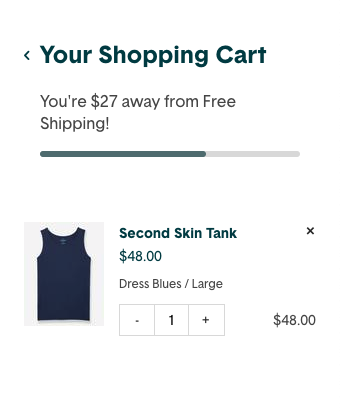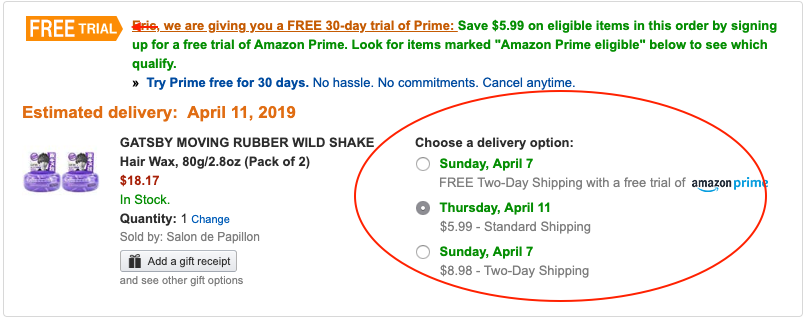Shipping is one of the most important elements of your eCommerce store. If you follow today’s best practices for shipping, you’ll be able to bring in more customers, boost customer satisfaction rates, and convert more visitors into paying customers.
And vice versa, if you don’t offer shipping that’s in line with your customer’s expectations, you may start to experience high cart abandonment rates, lower conversions, and fewer orders.
Using proper shipping best practices is a critical part of a great, seamless shopping experience. The buyer’s journey doesn’t end when they check out and make a purchase from your online store – it ends when the package arrives at their address, on-time and in good condition.
Want to make sure you’re setting yourself up for success? Let’s go over just a few of the best eCommerce shipping best practices – and explanations about why they’re so important.
1. Offer Free Shipping
It’s really hard to over-emphasize this one.
Yes, we know that free shipping is not “free.” Someone has to pay – and that may mean lower margins for you or higher prices for your customers.
But, thanks to large companies like Amazon, most customers shopping online today expect free shipping. And they have the statistics to back it up. According to Kissmetrics, 28% of customers will abandon their cart if free shipping is not available.
In addition, 90% of customers say that free shipping is one of the “biggest factors” when shopping online, and a survey by Monetate found that high shipping costs were the highest reason for cart abandonment – 61% of customers would abandon their shopping carts if extra taxes, shipping and fees were too high.
You need to offer free shipping. No complaining. No excuses. No whining about high shipping costs. Take the Nike approach and “just do it.”
If you don’t, you’re missing out on sales – it’s just that simple. But how can you do so, and make sure your profitability isn’t affected?
We recommend adopting a free shipping system that provides customers with free shipping once their order meets a certain total amount. Amazon, for example, provides free shipping on all orders over $25.
Here’s an example of what we mean: This type of model may help you save on shipping costs – especially if you are shipping multiple small items – and it will also encourage users to spend more on your website.
This type of model may help you save on shipping costs – especially if you are shipping multiple small items – and it will also encourage users to spend more on your website.
In fact, some studies suggest that adding a free shipping option like this can boost average order volume by as much as 30%.
For example, a shopper has $45 worth of items in their cart, sees a shipping charge for $7.95, but knows they can get free shipping for orders over $50.
At this point, here’s the internal conversation they’re having:
“I really don’t want to pay $7.95 for shipping. And I’m only five dollars away from getting free shipping. Let me see if I can find something else to get me to $50.”
They think they’re “saving money,” but in reality they could be spending even more had they just paid the $7.95 for shipping. Either way, you win. 🙂
2. Make Shipping Costs Obvious at Checkout
Even if you don’t offer free shipping, or you only offer free shipping on orders over a certain dollar value, you should make shipping costs obvious at checkout.
You can accomplish this by adding functionality to your shopping cart so when a customer enters their ZIP code, shipping fees are added to the subtotal when they’re viewing the order summary screen.
Here’s a good example of this from Abercrombie & Fitch:

Why does this matter? Because customers don’t mind paying for shipping, in some cases – but they don’t like surprises. Your customers are likely to abandon their cart if they can’t see shipping costs until the end of the checkout process, or if they’re blindsided by an unexpectedly high shipping cost. Some surveys have estimated that up to 55% of all abandoned carts are due to shipping costs.
Because of this, you need to make shipping costs obvious at checkout. You may even want to adopt a flat-rate shipping system if the items you sell are all relatively similar in size, shape and weight – this can help customers know what to expect when shopping, and prevent them from abandoning their carts due to unexpected shipping costs.
3. Show Customers The Expected Delivery Date
During checkout, we recommend providing customers with a delivery estimate for their item, based on their order date and their selected shipping method – the above screenshot from Amazon is a good example of this. It lets customers know exactly when they can expect to get their item, based on their selected shipping method.

This is easy to implement, too. If you’re using Adobe Commerce (or Magento Open Source), there are a number of shipping extensions you can use to estimate the shipping time of an order, and they’re all relatively inexpensive.
Why does this matter?
Because 87% of customers say that shipping time is a key factor in their purchasing decision. If you don’t provide your customer with an estimate of when their item will arrive, they may be less likely to make a buying decision – because they don’t know how long their item will take to ship.
We highly recommend using a tool to provide a delivery estimate on your store. You don’t have to guarantee delivery by this date – just provide a general guideline of the time it will take for the order to ship and arrive. This will provide your customers with more information, and make them less likely to abandon their cart.
4. Keep Your Customers in the Loop During Shipping
So, your customers have taken advantage of free or flat-rate shipping and placed an order with your store, and you’ve sent their item. Time to kick back and relax, right?
Not quite.
It’s a good idea to implement a system of communication that keeps your customers in the loop when it comes to shipping. 93% of customers report that receiving email confirmations about their orders contributes to a positive experience – so take this into account.
You should send your customers both an order confirmation when their order has been placed, and a shipment confirmation once their order has been sent to the delivery service. Doing so will help build trust, and ensure your customer remains properly informed throughout the entire process.
5. Take Action as Soon as a Shipping Problem is Reported – And Accept Responsibility
While packages lost and damaged by a carrier are not necessarily your responsibility, your customers will not see it this way.
Sure, you may not have lost the shipment yourself – but you did choose the carrier who lost the shipment. That means you’re on the hook to make things right.
As soon as a shipping problem is reported, you should take action:
- Check the shipment’s tracking details online.
- See if the address and contact information was entered correctly.
- Check with the carrier to see if it has been delivered, and to inquire about its status.
- Contact the carrier and follow-up until the issue is resolved
- Ship a replacement item to your customer as soon as possible.
You want to keep your customers satisfied, and making them wait for delivery until the package carrier has located a lost parcel is unacceptable.
Take it upon yourself to ship a replacement – you’ll eventually recoup your loss when the package carrier finds your item, or you may be able to get compensation for a lost or damaged shipment from your package carrier.
Follow These 5 Tips – And Make Sure You Meet Customer Expectations!
Implementing proper shipping best practices is absolutely essential for meeting – and exceeding – customer expectations.
So if you’re experiencing high cart abandonment rates, low conversion rates, or poor customer reviews, it may be worth your while to think about how you can incorporate these tips into your eCommerce store.
If you need help optimizing your shipping methods, policies or just general support for your store, please contact us. We’re an Adobe Commerce Gold Partner, and can handle any problem you throw at us.


Leave a Reply
You must be logged in to post a comment.